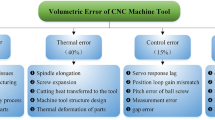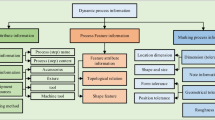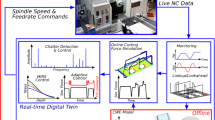Abstract
In the automotive or aeronautical industries, few parallel kinematic machine tools (PKM) are used in high-speed machining (HSM). However, the dynamics of these machine tool structures could be relevant for HSM since their acceleration potential is much higher than serial kinematic machine tools. However, a particularity of PKM is to have kinematic performances depending on the tool pose in the machine workspace. Thus, this paper proposes a method to increase the productivity of performed part machining with PKM by taking advantage of their kinematic performances, with the aim of decreasing the time of the non-cutting tool movements. Process parameters defined by this method are the machined part setup, the planning of the machining operations, the control of potential redundant axis and the definition of the tool paths between cutting operations. The developed method is achieved in four successive steps based on a modelling of the kinematic behaviour of a given PKM. Each step leads to define one of the process parameters with regard to the decrease of non-cutting time. Thus, this method only requires common optimization algorithms that increase it robustness and its adaptability to different structures of PKM. It is illustrated with drilling operations on preformed parts with the Tripteor X7 machine tool developed by the PCI-SCEMM Company.
Similar content being viewed by others
References
Terrier M, Dugas A, Hascoet JY (2004) Qualification of parallel kinematics machines in high-speed milling on free formed surfaces. Int J Mach Tools & Manuf 44:865–877
Hennes N (2002) Ecospeed—an innovative machinery concept for high-performance 5 axis machining of large structural components in aircraft engineering. In 3rd Chemnitz parallel kinematic seminar, Chemnitz, Germany, pp 753–762
Tlusty J, Ziegert J, Ridgeway S (1999) Fundamental comparison of the use of serial and parallel kinematics for machine tools. Annals of CIRP 48(1):351–356
Kim T, Sarma SE (2002) Toolpath generation along directions of kinematic performance. Comput-Aided Des 34:453–468
Bi ZM, Lang SYT, Verner M (2007) Dynamic modelling and validation of a tripod machine tool. Int J Adv Manuf Technol 37:410–421
Bonnemains T, Chanal H, Bouzgarrou BC et al (2009) Stiffness computation and identification of parallel kinematic machine tools. J Manuf Sci Eng 131:041013
Glavonjic M, Milutinovic D, Zizanovic S (2008) Functional simulator of 3-axis parallel kinematic milling machine. Int J Adv Manuf Technol 42:813–821
Muruganandam S, Pugazhenthi S (2010) Selection of optimal machining parameters for hexapod machine tool. Int J Adv Manuf Technol 46:801–810
Kim T, Son SK, Sarma SE (2004) On actuator reversal motions of machine tools. Mech and Mach Theory 39:299–322
Langeron JM, Duc E, Lartigue C, Bourdet P (2004) A new format for 5 axis tool path computation using Bspline curves. Comput Aided Des 36(12):1219–1229
Da Graça Marcos M, Tenreiro Marchado JA, Azevedo Perdicoulis TP (2009) Trajectory planning of redundant manipulators using genetic algorithms. Common Nonlinear Sci Numer Simul 14:2858–2869
Koukhi A, Baron L, Balazinski M (2009) Constrained multi-objective trajectory planning of parallel kinematic machines. Robot and Comput-Integr Manuf 25:756–769
Vosniakos GC, Kannas Z (2009) Motion coordination for industrial robotic systems with redundant degrees of freedom. Robot and Comput-Integr Manuf 25:417–431
Weck M, Staumer D (2002) PKM, current state and future potentials. Ann CIRP 51(2):671–683
Neumann KE (2006) Exechon concept—parallel kinematic machines in research and practice (PKS’2006), Chemnitz, Germany, pp 787–802
Pateloup S, Chanal H, Duc E (2010) Comparison of PKM and SKM performances for aeronautics part machining. In: 8th international conference on high speed machining, Metz, France
Pateloup V, Duc E, Ray P (2004) Corner optimization for pocket machining. Int J of Mach Tool & Manuf 44:1343–1353
Laverhne S, Tournier C, Lartigue C (2008) Optimization of 5-axis high-speed machining using a surface based approach. Comput-Aided Des 40:1015–1023
Castagnetti C, Duc E, Ray P (2008) The domain of admissible orientation concept: a new method for five axis tool path optimisation. Comput Aided Des 40:938–950
Pechard PY, Tournier C, Lartigue C, Lugarini JP (2009) Geometrical deviations smoothness in 5-axis high-speed flank milling. Int J of Mach Tools & Manuf 49:454–461
Wang Z, Wang Z, Liu W, Ley Y (2001) A study on workspaces, boundary workspaces analysis and workpiece positioning for parallel machine tools. Mech and Mach Theory 36:605–622
Affouard A, Duc E, Bourdet P (2004) Avoiding 5-axis singularities using tool path deformation. Int J Mach Tools and Manuf 44:415–425
Pessoles X (2010) Aide au choix du posage en usinage 5 axes continus par la modélisation du comportement cinématique des machines-outils. Ph.D. thesis in Mechanics, 2010
Harib KH, Sharif Ullah AMN, Hammami A (2007) Hexapod-based machine tool with hybrid structure: kinematic analysis and trajectory planning. Int J Mach Tools and Manuf 47(9):1426–1432
Robin V, Sabourin L, Gogu G (2007) Optimization of a redundant robotized cell: application to the finishing of cast parts. In: Proceedings of the 13th international conference on robotics and applications, pp 29–31
Owen WS, Croft EA, Benhabib B (2008) A multi-arm robotic system for optimal sculpting. Robot and Comput-Integr Manuf 24:92–104
Debout P, Castagnetti C, Chanal H, Duc E (2009) 12th CIRP conference on modelling of machining operations, San Sebastián, Spain
Derelli T, Filliz H (1999) Optimization of process planning functions by genetic algorithms. Comput Ind Eng 36:281–308
Tounsi N, Elbestawi MA (2003) Optimized feed scheduling in three axes machining. Part I: fundamentals of the optimized feed scheduling strategy. Int J Mach Tools and Manuf 43:253–267
Das K, Baki MF, Li X (2009) Optimization of operation and changeover time for production planning and scheduling in a flexible manufacturing system. Comput Ind Eng 56(1):283–293
Merlet JP (1997) Parallel robots. Hermès, Paris, ISBN: 2-86601-599-1
Putchler T (2006) Kinematic transformation for the Exechon concept in the SI-NUMERIK 840D—parallel kinematic machines in research and practice (PKS'2006), Chemnitz, Germany, pp 803–812
Pateloup S, Chanal H, Duc E (2010) Geometric and kinematic modelling of a new parallel kinematic machine tool: the Tripteor X7 designed by PCI. In Adv Mater Res 112:159–169
Sezimaria FP, Valder SJ (2000) Optimal trajectory planning of robot manipulators in the presence of moving obstacles. Mech and Mach Theory 35(8):1079–1094
Ding S, Mannan MA, Poo AN (2003) Oriented bounding box and octree based global interference detection in 5-axis machining of free-form surfaces. Comput Aided Des 36:1281–1294
Pateloup S, Bonnemains T, Chanal H, Bouzgarrou BC, Duc E, Ray P (2008) Machining performance optimization of parallel kinematic machines tools with regard to their anisotropic behaviour. In J Mach Eng 8(4):13–24
Author information
Authors and Affiliations
Corresponding author
Rights and permissions
About this article
Cite this article
Pateloup, S., Chanal, H. & Duc, E. Process definition of preformed part machining for taking benefit of parallel kinematic machine tool kinematic performances. Int J Adv Manuf Technol 58, 869–883 (2012). https://doi.org/10.1007/s00170-011-3453-9
Received:
Accepted:
Published:
Issue Date:
DOI: https://doi.org/10.1007/s00170-011-3453-9




